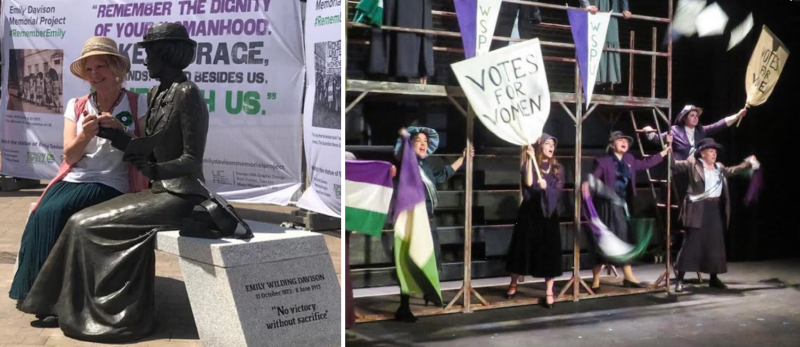Sarah Dewing, who initiated the statue of Emily Davison in Epsom’s Market Square reviews “Emmeline” a play about the foremost British suffragette, Emmeline Pankhurst, and the fight for the vote for women at the start of the 20th century.
“Emmeline” was performed at Esher Theatre on 24th and 25th February, as part of a tour that began in Oxford and will end in Manchester on 8th March, International Women’s Day, It is the debut play of young playwright and actor Beatrice Hyde, who also played Sylvia Pankhurst in the production. It was staged by the Theatre Lab Company, a London-based theatre company and was directed by Its Artistic Director, Anastasia Revi.
Beatrice condensed thirty years of suffragette history into two and a half hours, which sounds intense, but the interval broke it up nicely. She spent five years researching the Pankhursts and the events that took place around the struggle for government acceptance of women’s suffrage.
The play focused on the relationships between the newly widowed Emmeline and her three daughters, Christobel, Adela and in particular, Sylvia. Her relationship with her mother becomes increasingly fractious as the strategies pursued by the Women’s Social and Political Union, founded by Emmeline, become increasingly at odds with her socialist principles. These were encouraged further by her relationship with the founder of the Labour movement, Keir Hardie.
At the same time as we are let into the Pankhurst family dynamics, we are shown their social and political context including the debate around the cause between prominent politicians of the day and many of the stand-out events during the suffragette era, including the actions of Emily Wilding Davison at the Epsom Derby in 1913.
The play was well acted by a diverse cast of actors, with a stand-out performance by Georgie Rhys as Emmeline in particular. Direction was impressive, given the sheer intensity of the plot, and coordination of all the different aspects of the production.
The set was very simple but effective, with a two-tier stage with raised platforms at the rear and sides, minimalist lighting and a variety of props that often acted as symbols rather than literal objects. The sound design accompanying the production was an important aspect of the overall impact of the play, with several authentic and beautifully sung suffragette songs. reprieved throughout the play to rousing effect.
I loved the use of the background presence of an actor portrayed as the “heroic woman” motif throughout the play, representing the movement and its ups and downs. This was inspired by an illustration on the front page of an original Suffragette newspaper. I also thought the sound design and production really took the play to a different level.

For me, the psychological aspects of the play highlighted the personal costs, as well as rewards and triumphs, that are paid by those in single-minded pursuit of a mission to the exclusion of all else, including health, safety and relationships with loved ones. The play alludes to Emmeline’s drive to finish the work started by her beloved husband as the source of this obsession.
Ironically, without those like Emmeline and her daughters, who willingly devote their lives to a cause, social progress could not happen. In this case, women would not have the rights they have today, even if there is still a away to go. This is brought home to the present day at the end with a scene where Emmeline is portrayed as her statue outside the Houses of Parliament, This play is an impressive debut for Beatrice Hyde, but also a production that I would highly recommend for anyone with an interest in 20th Century history, women’s rights and psychological drama.
Sarah Dewing
Chair
Emily Davison Memorial Project
